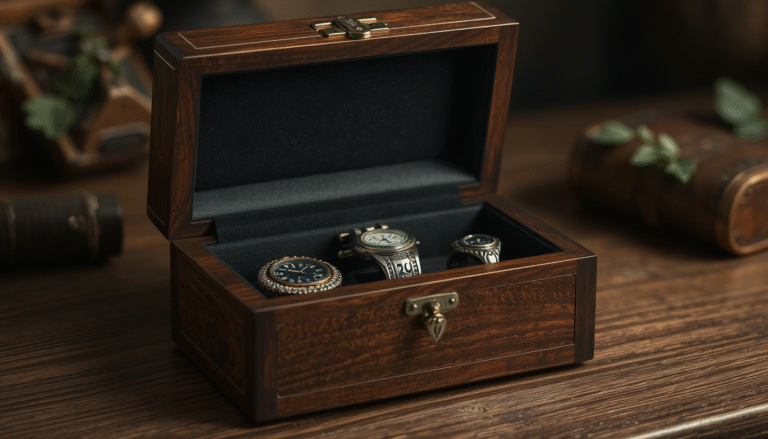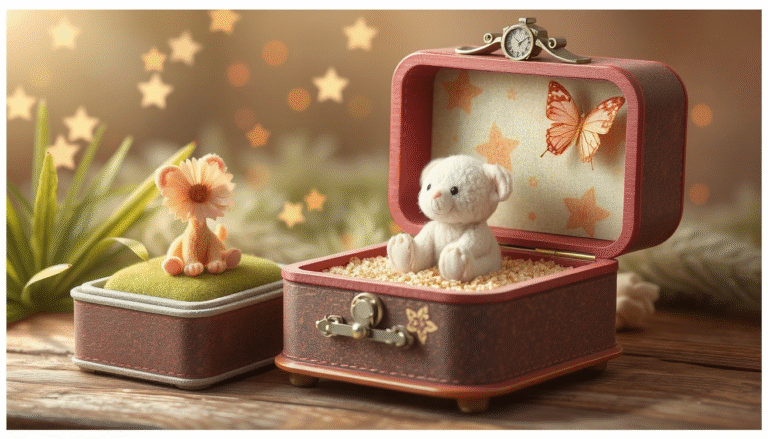Introduction: More Than a Box, A Personal Story
Unfortunately it’s seldom just a case of keeping something stored neatly in a simple wooden jewelry box! People search for deeper things. This could be an heirloom of the future, a gift to yourself, or a vessel of memories. You’re looking for an item with a tale in it.
Handcrafted, natural wood creates a lasting that’establishes emotional connection. The grain patterns and stingily sawed joints signal quality and intent. These details contribute to a story that has become ever more rich.
We understand what this search is like. We’ll guide you through the process. We will help you select the ideal wood and create a beautiful layout. Then we’ll demonstrate how to add personal touches to your box and take care of it so it will last generations.
The Heart of Customization: A 4-Step Guide to Designing Your Perfect Box
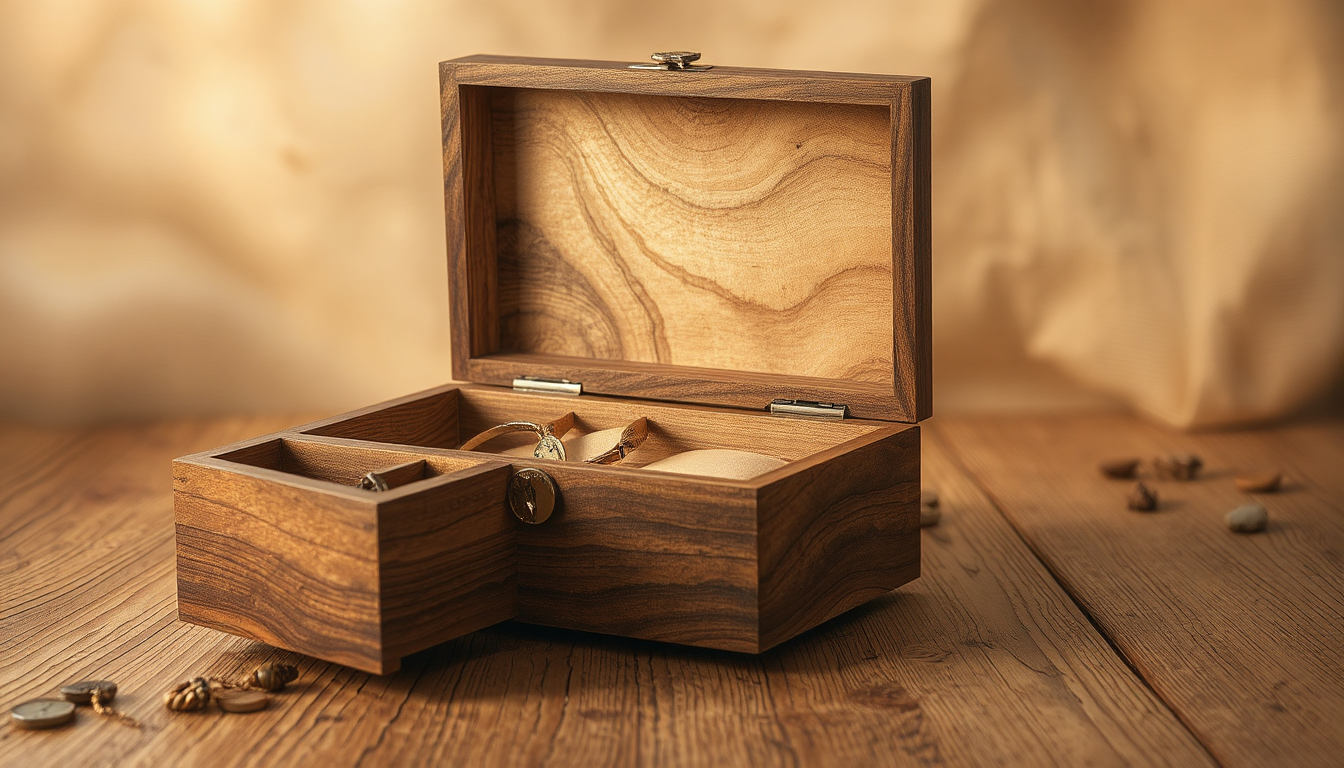
Customization may sound difficult, but it’s simply a matter of doing things together. There are four major components that we’ve divided it down to. Think of this as a journey, with every choice adding to the next. Your vision grows into an actual treasure.
Step 1: Choosing the Wood – The Soul and Story of Your Box
In other words, the wood creates the foundation for your box. More than anything else, its color, grain and feel are what give the box its character. It is the heart of the piece.
We work in a variety of woods, but some have emerged as favorites for beauty and workability.
-
Walnut: Rich, dark, and elegant. Its deep brown hues and intricate grain patterns scream luxury from the start.
-
Cherry: Noted for warm, reddish-brown hues, which will get richer over time. Cherry has a deep shine eventually, so it’s a lasting option.
-
Maple: Light, bright, and clean. Birds Eye or Curly Maple There are special type (Bird’s Eye or Curly Maple) that have a fantastic pattern that looks awesome with contemporary designs.
-
Oak: Strong, traditional, and tough. Oak: Oak is known for its straight grain and strength that gives the feeling of history.
-
Mahogany: A classic, old-world material. It has an inherent deep, even reddish-brown color and fine grain that have long made it the standard for quality furniture.
Beyond looks, think about where your wood comes from. We believe in craftsmanship that respects nature, which is why we use sustainably sourced wood certified by groups like the Forest Stewardship Council (FSC).
Step 2: Selecting the Design & Style – Form Meets Function
The design and shape of your jewellery box is a statement of taste. And here, you decide its existence — tucked away and understated or unabashed and eye-popping?
Common styles include:
Minimalist & Modern
Unfussy shapes, unpretentious finishes and good hardware. These boxes highlight the wood’s natural beauty and optimal shape.
Rustic & Natural
This look emphasizes the wood’s roots. It may have “live edge” (the natural edge of tree), visible joints and finish that shows off natural features.
Traditional & Ornate
For lovers of the details, this style can feature carvings, inlays and fancy hardware. It’s rooted in a long tradition of fine woodworking.
Beyond the overall look, think about these key elements:
-
Lid Type: A simple lift-off lid, a hinged lid, or a more complex design.
-
Drawers: How many do you need? Should they be hidden or visible?
-
Secret Compartments: A classic feature for hiding precious items.
-
Joinery: The way corners join shows quality. Visible joints like traditional woodworking joinery like dovetails are strong and show great craftsmanship.
Step 3: Perfecting the Interior – A Sanctuary for Your Treasures
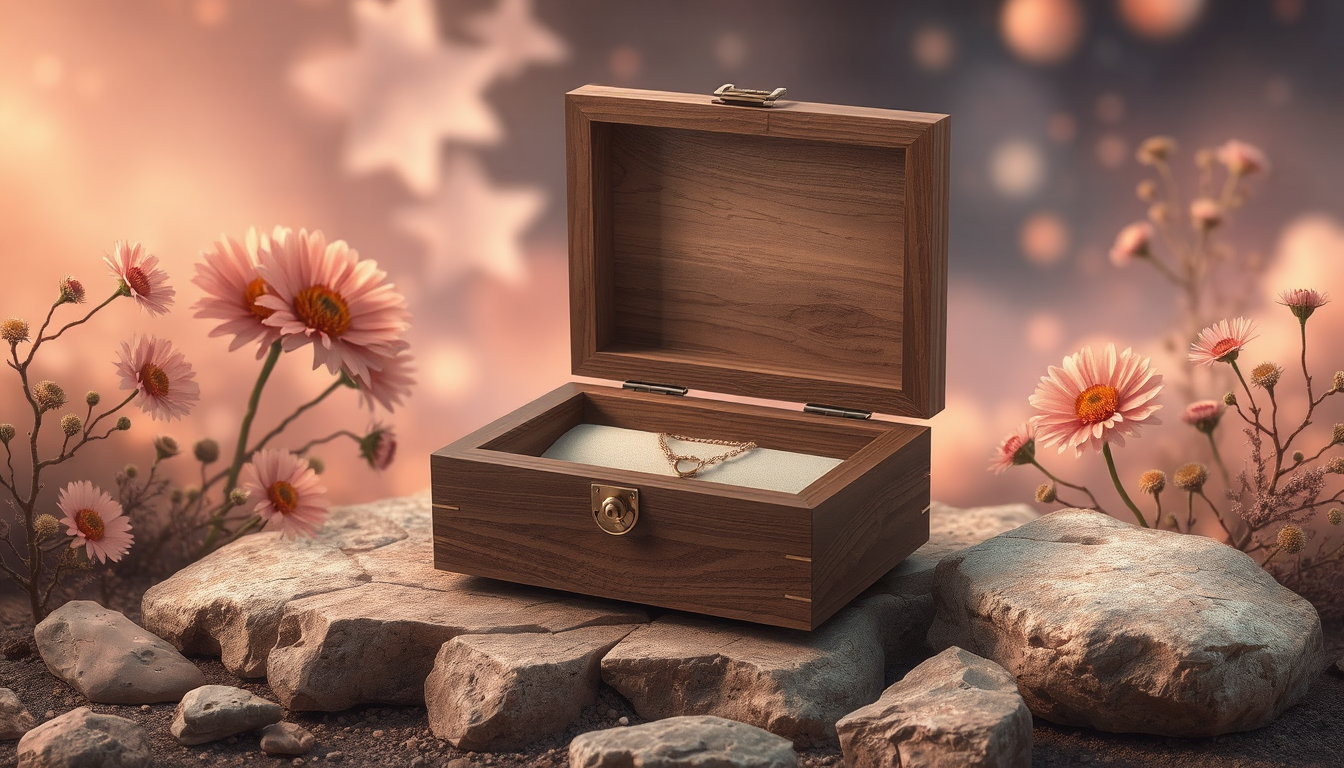
A truly custom box is designed from inside out. The interior protects, organizes, and displays your jewelry beautifully.
Lining adds luxury and prevents scratches and tarnish. Each material has its own qualities.
| Material | Pros | Cons | Best For |
| Velvet | The classic choice. Soft and non-abrasive. | Can collect dust over time. | Rings, delicate chains, pearls. |
| **Suls. | |||
| Suede | Luxurious feel, very durable, less likely to crush. | Usually more expensive. | Watches, bracelets, heavier items. |
| Linen | Natural, breathable, and simple look. | Less plush than velvet or suede. | Everyday jewelry, coastal or rustic styles. |
The magic lies in laying out the layout to your specific collection. We can make custom fitting compartments such as ring rolls, watch cushions, large deep bangles and necklaces, and small divided slots for earrings and charms.
Step 4: Adding the Personal Touch – Engravings, Inlays, and Hardware
This is the final layer of customization, where the custom wooden jewelry box becomes truly yours. These details transform a beautiful object into a personal statement.
-
Laser Engraving: We can laser engrave initials, a date, a short quote or even a personal handwritten message.
-
Wood Inlay (Marquetry): A picture or a pattern is made by using different woods. You can have a flower design, geometric design, or even a personal insignia inlaid on the top.
-
Custom Hardware: The pulls, knobs, and hinges matter too. Choosing hardware in brass, nickel, or bronze that matches the wood and style is an important final touch.
-
Engraved Plates: A satin metallic plate inside the box lid is another solution for main text or personal messages.
Commissioning a Masterpiece vs. The DIY Path: Which Journey is Yours?
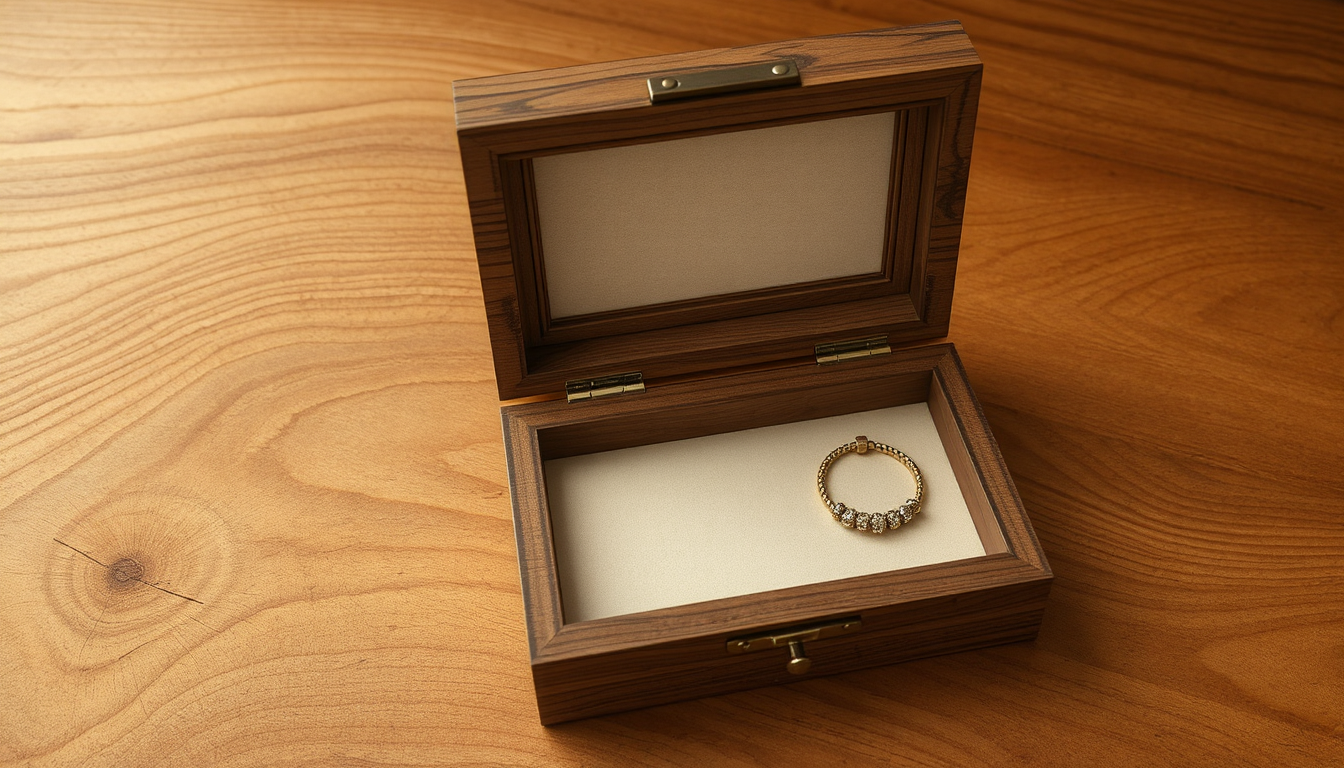
You’ve envisioned your dream box, but how do you build it? There are two satisfying routes: hiring a skilled craftsman or do-it-yourself.
We’ve seen people find great happiness in both camps. The best choice for you simply depends on what you care most about — whether it’s the final product, the creative process or some combination of the two.
| Feature | Commissioning an Artisan | DIY (Do-It-Yourself) |
| Outcome | Professional quality, perfect finish, heirloom-grade construction. | A personal, handmade creation with its own unique character and story. |
| Skills Required | Clear communication and a well-defined vision. | Woodworking skills, tools, patience, and problem-solving. |
| Time Investment | Research, communication, and waiting for creation. | Lots of hands-on time for design, construction, and finishing. |
| Cost | Higher money cost for labor, expertise, and materials. | Lower money cost (if you own tools), but big investment in time and tools. |
| Satisfaction | Pride in owning and gifting a unique piece of functional art. | Deep, personal pride in building something beautiful from scratch. |
For those inspired to try DIY, the journey is very rewarding. You can start with detailed woodworking plans from good sources to guide your first project.
How to Find, Vet, and Work With a Woodworking Artisan
If you choose to commission your custom wooden jewelry box, finding the right artisan is the most important step. This partnership is built on communication and trust.
Where to Look for Your Artisan
-
Online Marketplaces: From Etsy and CustomMade to countless others, there are literally thousands of makers to be found, helping you to sift through their portfolios and style to find your perfect match from around the globe.
-
Fine Craft Fairs & Art Shows: Consider a fair where you can meet artists in person, view their portfolios up close, and talk to them in person about your project.
-
Local Woodworking Guilds: Most places have some kind of woodworking group. They often have a list of members on their websites, or they may recommend individuals.
-
Instagram & Pinterest: Use hashtags like #woodworking, #customjewelrybox, #woodart, and #finefurniture to find artisans through their visual portfolios.
Vetting the Artisan: Key Questions to Ask
When you have found artists you might be interested in, reach out with very straightforward questions to ensure they fit your project.
-
Can I see examples of your past work, especially jewelry boxes?
-
Which woods do you like working with most?
-
What is your process for custom designs? How do we work together on the details?
-
How long will it take to complete and what is the payment schedule?
-
How do you package and ship delicate, valuable items?
Remember that a truly custom piece is an investment. Depending on the wood, complexity, size, and the artisan’s reputation, a project can cost from a few hundred to several thousand dollars.
Ensuring a Successful Collaboration
The best results come from working together well. Be clear in your communication and provide visual examples if you have them. At the same time, trust the artisan’s knowledge about materials and construction methods. Understand that creative work takes time, and value the process. By doing so, you’re not just buying a product; you’re supporting craftsmanship and the value of American craft.
Preserving the Beauty: Long-Term Care for Your Wooden Jewelry Box
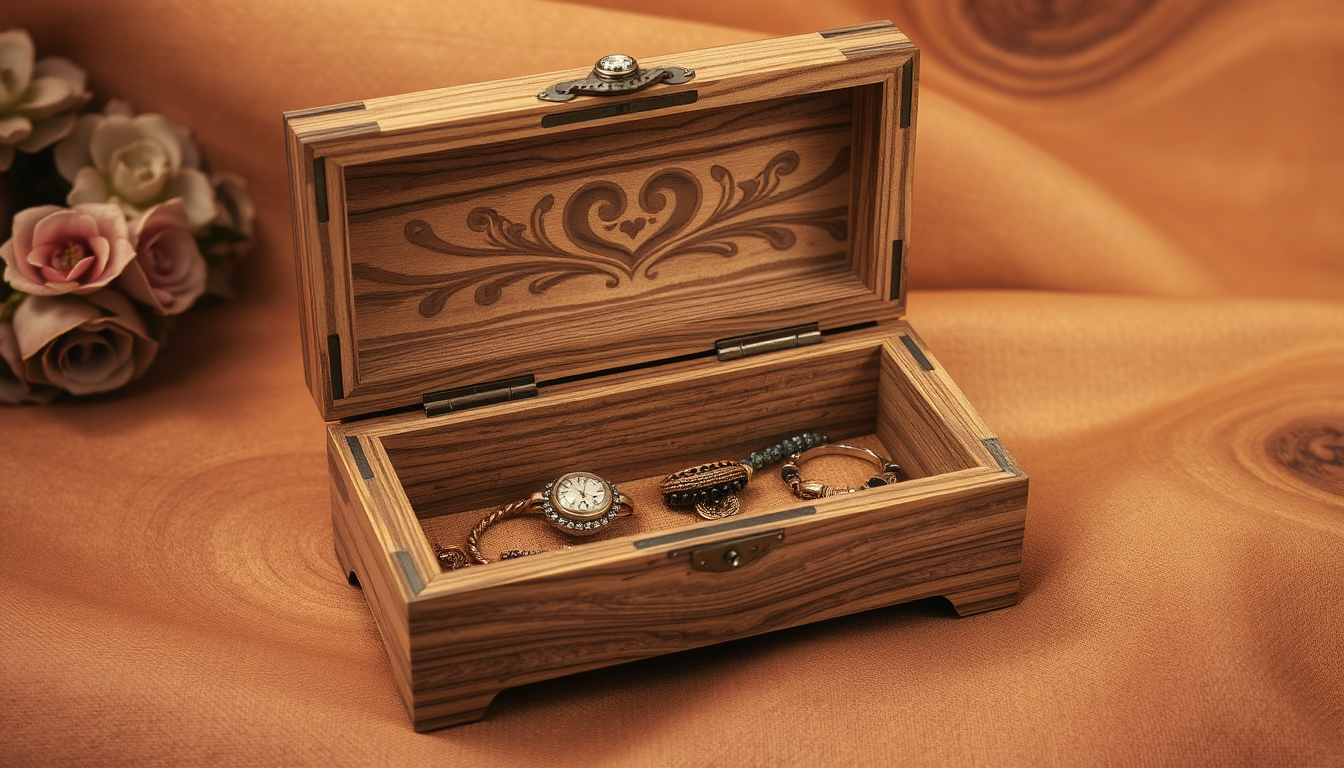
Your custom wooden jewelry box can last for generations. With simple care, its beauty will deepen over time.
-
Dusting: You should regularly dust with a soft, clean, lint-free cloth (microfiber is a good choice).
-
Sunlight: Keep the box out of direct sunlight. UV rays can fade the wood’s color over time.
-
Humidity: Wood responds to its environment. Keep the box away from big changes in humidity, like next to a radiator or in a steamy bathroom, to prevent warping.
-
Cleaning: For fingerprints, wipe with a slightly damp cloth and immediately wipe dry with a soft cloth. Never use harsh chemical cleaners.
-
Polishing: Refresh finish one or two times a year with quality furniture wax or polish. And be sure it’s suitable for your particular wood and finish — your craftsman can recommend the right one.
For more detailed advice, museums that manage furniture collections offer expert guidance on caring for wooden objects.
Conclusion: Your Custom Jewelry Box – A Future Family Heirloom
A personalized wooden jewelry box is more than a box. It is a slice of personal history, a curator of memories and a statement of what you value.
From selecting the wood to making a personal statement, such as an engraved initial, every decision contributes to its story. The box you use to span gorgeous, tastes achievement and gives you a love legacy.
This is the craftsmanship in all its glory. It makes things to live with, to care for, to leave as an heirloom — a beautiful, useful heirloom in the future.
FAQ
-
What types of wood are best for custom wooden jewelry boxes?
You can choose between walnut, cherry, maple, oak, and mahogany, each of which boasts individual grain patterns, colors, and qualities that will influence the appearance and longevity of your box. -
How much does a custom wooden jewelry box typically cost in 2025?
The cost varies from a few hundred to a couple of thousands of dollars depending on many factors such as wood types, complexity, size, customisation opportunities, skillfulness of the maker. -
What personalization options are available for custom wooden jewelry boxes?
Some common choices are wood marquetry or laser engraving, custom hardware in brass or nickel and various engraved metal plates for special messages or dedications. -
How long does it take to create a custom wooden jewelry box?
Creation time varies by artisan and complexity, typically ranging from 2-8 weeks for handcrafted pieces, including design consultation, wood preparation, construction, and finishing. -
How should I care for my custom wooden jewelry box to ensure it lasts for generations?
Keep away from direct sunlight and humidity changes, dust regularly with a soft cloth, clean with a slightly damp cloth when needed, and apply quality furniture wax once or twice yearly.


